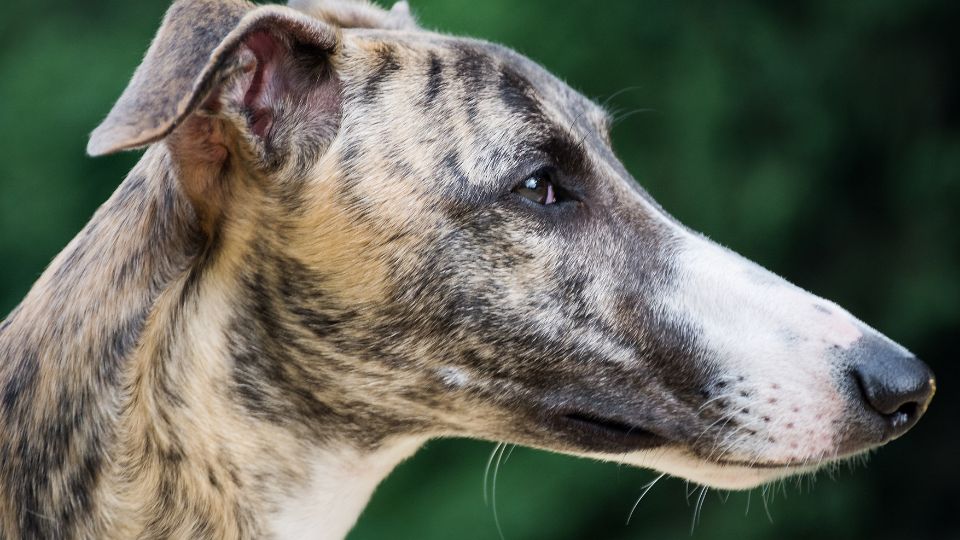Despite its somewhat misleading name, the Greyhound breed is not named for its grey fur, as the dogs come in a variety of colors. The name likely originates from the Old English term “grighund.”
Origin of the Term “Greyhound”
The Greyhound was first mentioned by name in an inscription dated to 800 BC in Egypt. However, the English name “Greyhound” did not come into existence until many centuries later. There are several theories about the origin of this name. Some believe it derives from the Old English “grei,” meaning dog, and “hundr,” meaning hunter. In this context, the term “Greyhound” could be interpreted as “hunting dog.”
Another theory ties the term to the Old Norse “Grey,” which means female dog. According to this perspective, a Greyhound would be a “hound for a female,” referring to the breed’s popular use for hunting by women in antiquity.
The Color Misconception
Greyhounds are not defined by a grey coat. Instead, this breed exhibits a wide range of colors, including black, white, fawn, red, blue, and various mixed patterns. There is a grey color in the spectrum of Greyhound coats, but it is relatively rare.
- Black: This is the most common color among Greyhounds.
- White: Though less common, white Greyhounds are quite striking in their appearance.
- Fawn & Red: These colors range from light tan to deep, rich red.
- Blue: A slate grey or bluish tone.
- Brindle: This is a striped pattern that can come in different hues.
The following table summarizes the common colors in Greyhounds:
| Color | Description |
|---|---|
| Black | Deep black coat |
| White | Pure white coat |
| Fawn | Light brown to tan coat |
| Red | A variety ranging from light red to rich, deep red. |
| Blue | A slate grey or bluish tone |
| Brindle | A striped pattern, comes in various hues |
A Breed Rich in History
The Greyhound breed has a rich history dating back thousands of years. These dogs were initially bred for hunting due to their incredible speed and keen sight. Ancient Egyptians, Greeks, and Romans all valued Greyhounds for these traits, and the breed was often associated with nobility and the aristocracy.
Over time, Greyhounds have transitioned from hunting dogs to racing dogs, where their speed is highly prized. Despite this change in societal role, Greyhounds have continued to be beloved pets and members of the family, known for their gentle demeanor and friendly nature. The name “Greyhound” remains a nod to their hunting origins and historical role.
However, it’s also worth mentioning that Greyhounds’ racing days could potentially influence the breed’s name misunderstanding. A subset of the breed, known as “blue Greyhounds,” are often used in dog racing. This specific name is derived from their unique coat color, which is a dilute black, appearing as a sort of bluish-grey. This has led some to believe that all Greyhounds are, in fact, grey.
Etymology of “Greyhound”
Exploring further into the etymology, the word “Greyhound” in Old English was spelled as “grighund.” “Hund” is the antecedent of the modern word “hound,” but “grig” remains a mystery. It does not translate to “grey” in Old English, as “grey” would have been “grǽg.”
Old English language experts speculate various roots for the term “grig.” Some theories:
- It might be derived from Old Norse “Grey,” meaning female dog.
- It could be connected to “grei,” another Old English word for dog.
- Some argue it might be related to the Welsh term “cri,” which translates to a dog’s bark.
Despite these theories, the exact etymology remains elusive.
The Greyhound Throughout History
Greyhounds have a dense presence in historical records, appearing in various cultures and eras:
- Ancient Egypt: Greyhounds were revered by the ancient Egyptians and often depicted in tomb art dating back to 4000 BC.
- The Middle Ages: In medieval England, Greyhounds were prized by the aristocracy. Due to the Forest Laws, only the nobility could own and hunt with them.
- Tudor England: Henry VIII, a known Greyhound enthusiast, changed the law to allow butchers, blacksmiths, and “all freemen” to own Greyhounds.
- Modern Age: In the 18th and 19th centuries, Greyhounds were imported to the Americas, where they became popular for hunting and eventually for racing.
Here’s a snapshot of Greyhound emergence in different eras:
| Era | Event |
|---|---|
| Ancient Egypt | Greyhounds are depicted in tomb art. |
| The Middle Ages | Ownership & hunting with Greyhounds limited to the English nobility. |
| Tudor England | Henry VIII expands law to allow more people to own Greyhounds. |
| Modern Age | Greyhounds are introduced to the Americas and become popular in hunting and racing. |
Greyhounds Today
While Greyhounds are less commonly used in hunting today, their incredible speed, reaching up to 45 mph, makes them exceptional racing dogs. However, increasingly strict regulations on dog racing and growing awareness about the industry’s potential mistreatment of dogs have led to a decline in Greyhound racing in recent years.
Today, many retired racing Greyhounds are adopted into loving homes. Despite their racing background, Greyhounds are known to be “45-mph couch potatoes,” given their calm and gentle nature, and their love for lounging indoors. They have a lifespan of 10-14 years and are generally healthy dogs.
Even though the origin of the term “Greyhound” remains a mystery and doesn’t necessarily correspond to their color, the name is an integral part of their rich, centuries-long history and continued popularity.




